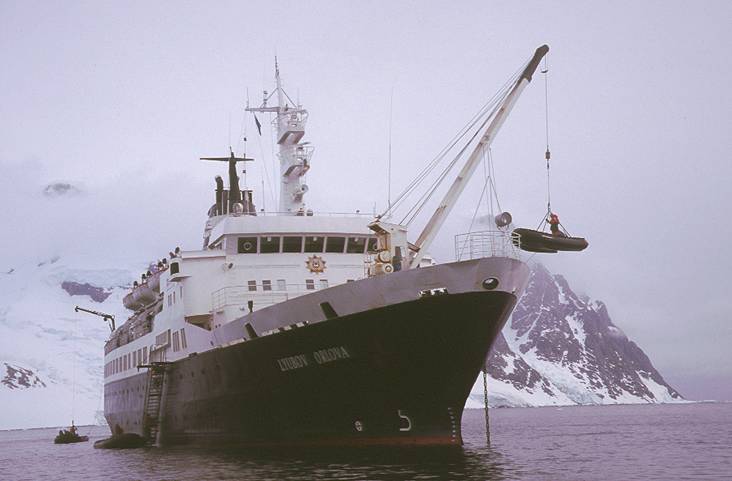
Expand
your screen to full size, so the pictures will come in right.
Antarctic
Adventures
Galen
Berry
Day
1, Dec. 1, 2009
Ushuaia, Argentina, is the southernmost city on earth.
It’s on the bottom edge of Tierra del Fuego, a large island that’s on
the bottom edge of South America. There’s
a large sign at the seaport, visible to any ship coming in, that says in Spanish
and English: “Ushuaia – End of the World, Beginning of Everything!”
I flew in from Buenos Aires the night before, and had walked about 40
blocks all over town in the wind and snow, looking for a grocery store, which I
never did find. For a town of 60,000
people, that was kind of weird. So I
had to settle for a bag of Cheetos and a Pepsi.
I stayed at the Hotel Albatros, which was pretty elegant, except
there’s no way the crowds of people in the lobby heading out to Antarctica can
look very elegant, all bundled up in their below-zero clothes and earmuffs.
Today, after breakfast, there were several free hours before everybody
had to be on the boat, so I walked another 40 blocks or so.
Still no grocery stores. I
walked to the Renault dealer and reserved my rentacar, a Renault Kangoo, for two
weeks later when I’d be back in town; also I went to the Aerolineas Argentinas
office to try to get a better seat assignment for when I would fly back to
Buenos Aires later, but after sitting there quite a while they finally informed
me that all their computers were down. And
not just their office, the entire city’s internet was off.
(Two weeks later, when I got my Kangoo, I drove all over town for an
hour… and still never found a grocery store in the whole place.
Apparently Ushuaians don’t eat.)
About 4 pm, all of us going to Antarctica, about 100 people, got on
several Rumbo Sur busses, and only went a few blocks to the port, where we had
to get off, go through metal detectors, and get back on the bus.
Then, about 5, we got onto our boat, the Lyubov Orlova.
It’s kind of a rusty old tub, built long ago in Yugoslavia, which ran
aground in Antarctica in 2006, but that was a good thing for us, since that
meant that the hull had been extensively repaired and strengthened, better than
ever. It is named after a famous
Russian actress from long ago; she would surely not have been too impressed at
the honor. The ship crew was all
Russian, though our expedition guides were mostly American.
We sat around inexplicably until 7 pm, then finally we started to move.
The weather in Ushuaia had been awful, even though it was almost
summertime down there, so it wasn’t too pleasant on deck.
I went up clear to the top, which is open all around to the best views
you can get on board – and I found my favorite spot!
There was some kind of a little room there, with all kinds of mysterious
rusty, greasy old equipment lying around, and you could look straight thru the
grates in the floor for about 6 stories down.
It smelled badly of diesel and oil fumes, but it was warm!
There was constant warm exhaust air blowing by from the great diesel
engines far below. For some reason,
they left the heavy metal door to the room open.
During the entire trip, I never saw a single other person go in there the
whole time. But I loved my spot… I
would sit on the floor and watch the world, or the ocean, go by, toasty warm,
for hours and hours, even on the coldest, windiest days and nights.
I spent many happy days in that little room, sitting crosslegged on the metal
floor with my knees poking out the door, leaning back on some bizarre piece of
ancient forgotten equipment shaped like 2 cones welded end to end, which
actually made a nice back rest. If it got a bit too warm, I’d just scoot
forward and stick my feet out the door. I
stayed there this first night till suppertime, the last person to leave the
deck. We were sailing the Beagle
Channel; Argentina was on one side and Chile on the other.
The snowy mountains rising straight out of the ocean were beautiful.
I didn’t like suppertime! The
ship is famous for its gourmet meals, but before too many days passed I was just
wanting some fried chicken or catfish instead of capers, raw salmon, aubergines,
and white asparagus spears. And a
Coke! You had to pay for anything to
drink other than water or their ghastly version of iced tea, which wasn’t even
iced. So I did without (which
didn’t hurt me any), until the day when I finally stepped onto the Antarctic
continent itself 6 days later. That
day I rewarded myself with a can of Coke, for $2.50!
I’d far rather they had done without the lamb chops or duck à
l’orange or calamari, and just given us free drinks.
But the main thing I didn’t like was the social side of all the meals
– you always had to sit at a table for 6, meaning with 5 strangers, and you
had to act all friendly and chatty, which of course was a sore trial for me; I
just wanted my food quick, so I could get back up to my cozy spot on the top
deck. I can fake the social kind of
stuff very well if I have to, for 2 or 3 meals… but for 33?
Why should I have to? Places
like Antarctica (and Iceland, and Patagonia) attract the loner type; they should
know and understand that! People who
want to chat with strangers go on Caribbean cruises!
Also, the meals weren’t buffet style, they were quite formally served
by a team of pretty Russian girls, but that meant every meal took over an hour,
each one being in 3 or 4 courses, with dessert too.
So for three hours every day, you were faced with some stranger straight across
from you. That was by far my major gripe about the whole trip; otherwise, the
ship did a magnificent job of absolutely everything.
After dinner, I went back up to my little spot and stayed there till
about 11 pm, watching the shoreline and the islands of Tierra del Fuego till we
sailed out into the open seas. Again
I was the last person to come in. I
had originally been assigned to a small room way down in steerage with 3 other
guys, but somehow I got moved up 2 decks to a much nicer, larger room with
windows that would open (it was always very warm in the room and I didn’t
figure out how to control the temperature until the last day).
The room should have been far more expensive, but I guess it didn’t
sell so it was like a free upgrade. I
shared it with a guy from California, Frank, who worked for the Cirque du Soleil,
doing carpentry and maintenance, and just travels all the time with them and
doesn’t have a home; he was based in Brazil working with a tent show.
The room had a bathroom and a shower – actually, it was pretty high
class, since we had both paid for the cheapest tickets.
The
Orlova,
lifting one of the Zodiac boats. Two
more are on the left side.

Day
2, Dec. 2, 2009
I knew I was not going to get seasick.
I’ve never been seasick in my life, but then again I’d never been on
a boat like this before; just on huge ferries on calm seas, in Finland, or
Mexico, or Greece. And this boat was
really rocking. I had started taking
my seasick pills 2 days before, and had my ginger pills too.
I knew that if you waited till you felt sickly to start taking them, that
it was too late, so I was prepared. Besides,
they had candied ginger in the lounge area, which is supposed to be the natural
remedy, and you could have all you wanted (it’s nasty).
I skipped breakfast, I was not about to get up at 7:30, with nothing to
see outside but the ocean, so I just slept till 12, still kind of worn out from
all the stress of the trip clear down to the bottom of the earth.
At lunch, I sat next to the Irish couple, Mags and Paul, whom I had met
on the plane down from Buenos Aires. I
ate my salad, but felt a bit weird. I
ordered my main course from one of the Russian girls, but kept feeling like I
had fever. I ate all my salad,
trying to be cheerily conversational, but before long I decided I better just go
back to the room. I told the
waitress to cancel my order, and started back, lurching around a bit like
everybody else on the boat. I
didn’t get far before I realized I was never going to make it to the room and
that I better find a bathroom quick. Luckily
I had already seen one tucked around a corner in an area not many people went
by. I rushed in, and another young
guy was already in there, squatting down on the floor in front of the toilet
barfing up his gizzard. He looked up
apologetically and said, “Sorry…” I
said, “Me too!” and grabbed the sink, and we puked in unison.
We didn’t mention our little incident again for the rest of the trip,
tho we’d kinda grin when we saw each other in later days.
It was our little secret.
I went straight back to bed and slept for 22 hours!!
That was the only place where I felt sort of okay.
I did get up once, and crawled down to the dining room at suppertime, and
brought an apple, orange, banana, and some grapes back to the room, but that was
all I managed to keep down for the whole day, and was all I wanted.
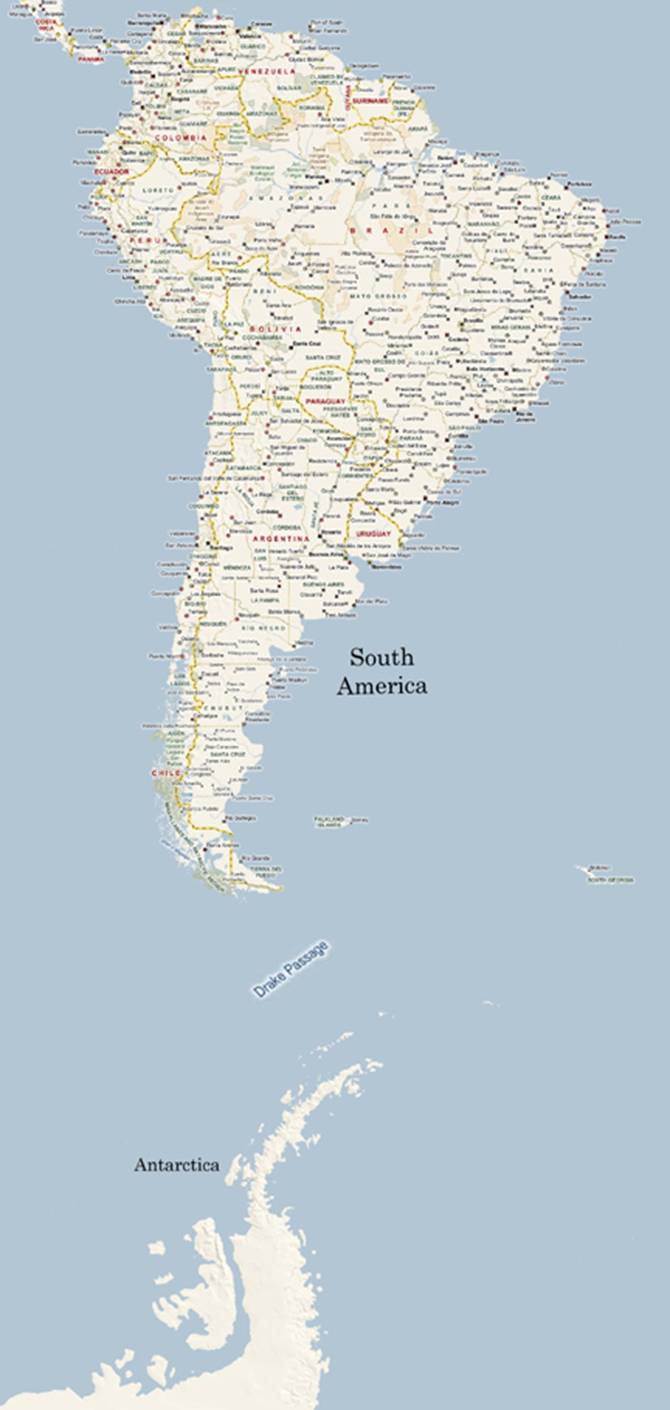
Day
3, Dec. 3, 2009
I woke up feeling just fine even though the ship was rocking as much as
ever. I even went down for
breakfast, and totally porked out on all their good stuff.
The Drake Passage, the large strait of water between South America and
Antarctica, is one of the roughest, windiest, coldest seas in the world, and
it’s the part of the trip everybody dreads the most, since it’s always 2½
days of travel with nothing at all to see, with the ship wildly lurching side to
side the whole time; you can’t even walk around without clinging to the bars
all along every wall. But
apparently, we were very lucky… our expedition leader, Kara, who has been
across the Drake more than 180 times, said our trip down was the second
smoothest crossing she had ever seen – it was almost a case of the mythical
“Drake Lake”, which practically never happens, instead of the more usual
violent, turbulent Drake Passage. Well
I was glad it wasn’t any worse. And
was not looking forward to the trip back, already!
We passed our first iceberg during supper, which they announced on the
loudspeaker like it was some grand event, and everybody ran outside on deck to
see it.
Day
4, Dec. 4, 2009
We woke up to nice sunny skies, and land in the distance!
The mainland was to the left, and various islands and icebergs were
everywhere. It was magnificent.
Of course there are no docks and piers, much less ports in Antarctica;
that would be against all the international agreements to leave it in as natural
a state as possible. So twice a day
they would lift the Zodiac inflatable boats down into the sea with big cranes,
and we would troop down the gangway and precariously climb aboard them, about 12
people in each plus the Russian driver. You
had to sit on the outside, inflated rim of the boat, there weren’t any seats,
which was scary at first and you clung on for dear life, but soon it was fun and
I was turning every which way for good views, even standing up to take pictures.
Going out was quite a process though; every time, you had to put on all
your gear – long underwear, ski pants, ski coat, toboggan cap, sunglasses,
gloves, life jacket, and tall rubber boots, plus carry your camera where it
wouldn’t get wet. It never failed
I forgot something or other and had to rush back up to the room.
This morning we didn’t land anywhere, we just cruised around for an
hour looking at icebergs and the Melchior islands.
We saw our first penguins! They
were gentoos, the most common kind in the area, but soon we saw some chinstrap
penguins too, which are cute. There
were just 2 or 3, standing around on top of some of the snow-covered rocks.
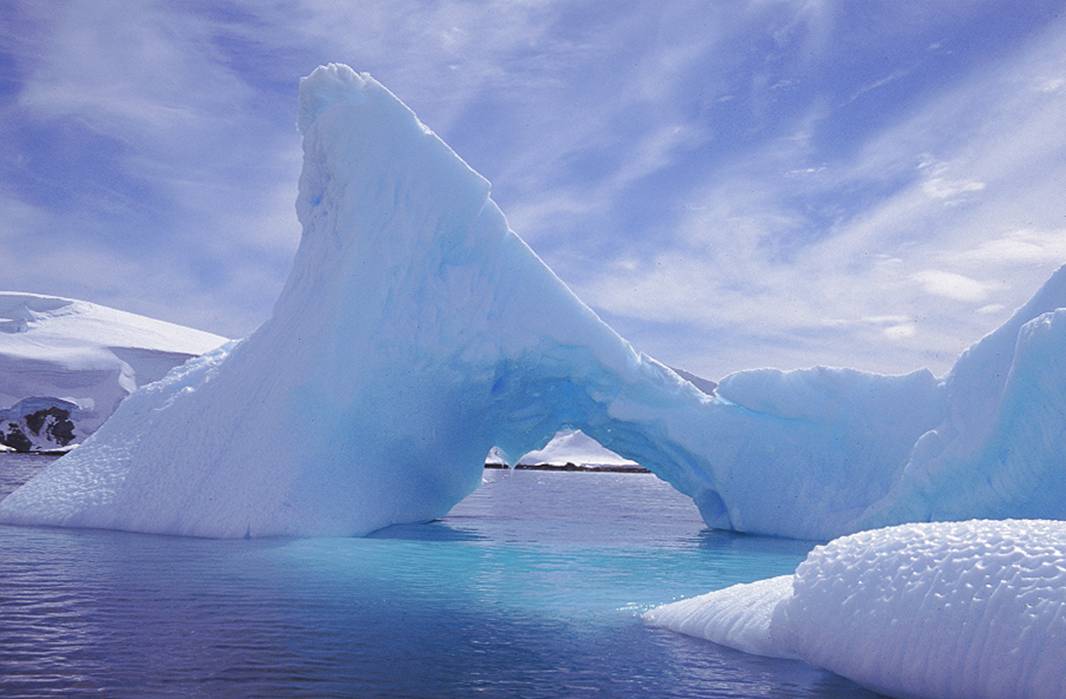

After lunch, though, it was time to hit land!
Not the continent itself, it is so rocky with such enormous cliffs and
glaciers along the shores, that there are very few places you can even go
ashore. So we stopped at little
Danco Island, which is quite flat compared to most, and has a large gentoo
colony.
We had to jump out of the Zodiacs into the water, but it wasn’t too
deep, then go up the extremely rocky shore to the snowy plains.
We immediately learned what walking in Antarctic snow is like… no fun!
It might look nice and solid, but it never is.
You sink down with every step up to your knee, at least… sometimes up
to your hip. Walking is extremely
tiring. You learn to stamp your foot
into the snow about 3 times before every step, not putting your whole weight on
your foot until you’ve packed the snow down a bit.
Then it might hold your weight.
But still, no matter how careful you are, you’ll still break thru
pretty often and your foot will drop down to knee level in the snow, or worse.
Penguins are goofy! You’d
think, after millions of years of living in the snow, that they’d sort of have
it down pat… but no, they are every bit as klutzy as we humans were.
I saw the same poor little guy fall splat on his face three times in
about a six-foot distance. They are
incredibly well adapted for ocean life, for swimming… they almost seem to fly
in the water, often shooting clear out of the water in large leaps, over and
over, like dolphins do. But on land
they’re so clumsy it’s hilarious. When
they come up to a steep bank you can almost see them thinking, oh no, how am I
going to ever get up this thing? But
they are very patient, and just try and try until they make it.
Some make their nests clear up on the very top of the islands, and you
wonder why they would go to such trouble.
We never did see any of the large, famous Emperor penguins, and didn’t
expect to… they live much further south and far inland, and only one ship ever
makes the trip down to visit them, the Kapitan Khlebnikov, which is an
icebreaker ship; but even it got stuck in the ice for a couple days the week
before we sailed, and it’s being retired from tourism service anyhow, the Russian government wants it back for
use in the Arctic.
Besides that, they charge over $12,000 to go see the Emperors, so I guess
I’ll do without. But the littler
ones are lots of fun to watch. They’re
not afraid of anything on land, they have no land predators, so they just ignore
humans, though they’re very wary in the sea, always looking out for killer
whales and leopard seals. We were
instructed not to disturb their activities – the rule was:
penguins have the right of way! In
other words, if you’re walking somewhere, and a penguin is walking your way,
you stop and just stand there and let him go past; you don’t make him alter
his route to accommodate you. This
is his land, not yours! Having
humans around doesn’t seem to harm them at all though, in fact there is some
research that has shown that penguin colonies near the various Antarctic
scientific stations actually prosper better than more isolated colonies.
It’s probably because having people around scares predator birds away
from eating the penguin eggs and the babies.
Day
5, Dec. 5, 2009
This morning we went through the famous Lemaire Channel, or “Kodak
Gap” as some call it, because it is so picturesque.
It is a narrow channel between Booth Island and the mainland, and is
quite possibly the most photographed area on the whole continent, because of the
grand rocky cliffs that rise high on both sides, making even a large ship seem
small beside and between them. Not
only is it scenic, but the protected waters are usually as still as a lake, a
rare occurrence in the southern seas. Sometimes
it has too many icebergs for ships to dare go through it, but we were lucky.
We were heading for Petermann Island.
This was as far south as we went; it is a small island that has an
emergency refuge hut built by Argentina in 1955 in case of shipwrecked sailors,
and a large wooden cross commemorating three members of the British Antarctic
Survey who died in an attempt to cross the sea ice from one island to the next.
It also has the southernmost colony of gentoo penguins, but we had seen
plenty of them. We were here to see
the little Adélie penguins, a more southerly species, and this was the northern
fringe of their range. The two kinds
shared nesting grounds and seemed to get along fine (though penguins are always
squabbling, so how would you know). They
are smaller than the gentoos, with shorter beaks and longer tails.
And every bit as clumsy. The
island had a nice pass between two peaks that we could hike to, with a fine view
towards the west.
Gentoo
on Petermann Island:
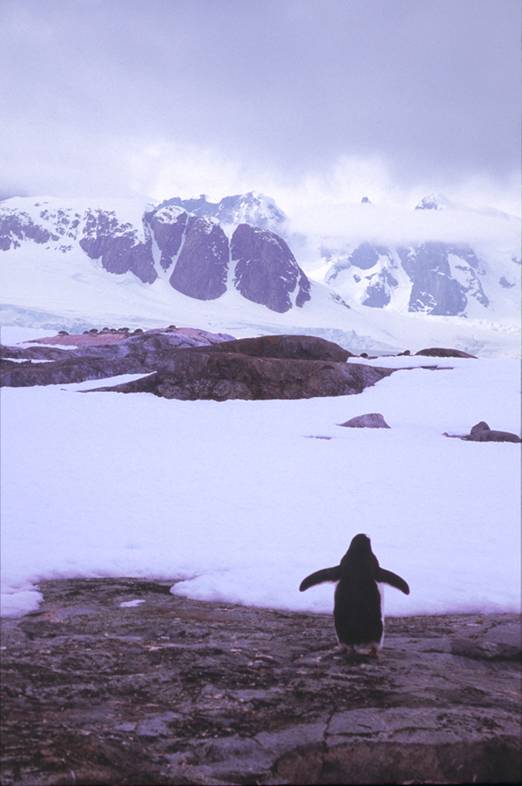
In the afternoon we got on the Zodiacs again, and went to an “iceberg
graveyard”, a shallow bay where icebergs often get stuck, scraping the bottom
of the bay, and then just sit there, sometimes for years, melting into all kinds
of crazy and wonderful shapes. At
first I was quite busy feeling miserable, because it was cold and windy.
But very soon I forgot all about that, because being right there in a
tiny boat beside those magnificent giant bergs made me forget about everything
but taking gobs of pictures. It’s
incredible how much variety there is to the icebergs… some have giant icicles
hanging down all over them, and so then when the iceberg shifts its weight and
the whole thing tilts, the icicles are all pointing sideways or at an angle,
which is totally weird to see. Some
of them have pools of melted water on their flat areas, which are of the most
amazing turquoise blue colors. Some
have giant streaks of dirt running all the way through them, where they were
obviously scraping against the ground back when they were still glaciers, before
breaking off into the sea. To think
that something so huge, so impressive, so solid, is so temporary is what makes
them fascinating. The scenery that I
usually photograph on my vacations, the Southwestern desert states, has hardly changed for
thousands of years; but here, if you went back a year later, even a few months
later, the scene in the bay would be entirely different.
We didn’t get to see any of the extremely rare crystal clear green
bergs; most bergs are broken off from glaciers, which are rivers of compressed
snow, and so are white because of millions of microscopic air bubbles between
flakes. But after the bergs float in
the ocean for a long time, sometimes sea water freezes and attaches onto the
very bottom of the bergs; so that ice doesn’t have the bubbles.
Very occasionally, a berg can become unstable because of uneven melting,
and can turn completely upside down, exposing the bottom side; they say they are
so clear you can see for many yards straight inside of them, and they are green
because of tiny specks of algae. I
did see a small one in Iceland 2 years ago, though.
While we were putt-putt-ing around among the bergs, suddenly – a pirate
boat appeared! Black skull and
crossbones flag and all!! Help!!!
Our driver made us all hang on tight, and we went flying across the water
on a wild, bumpy, wet ride, all through the islands and icebergs, even through
passages so narrow we could touch ice on both sides… and still, the other boat
came right behind us. It was a
Zodiac like ours, too, so it could go anywhere we did.
So our driver finally stopped and “surrendered”.
I was thinking, this is stupid… it’s obviously a joke.
And it was, but it turned out to be a very good one.
The “crew” on the pirate boat was all the Russian girls from the
dining room, and they had brought us a big tank of hot chocolate.
And a bottle of rum, of course, appropriate for a pirate ship.
They poured it out in cups for us (I got mine rum-less), then took off to
“raid” the other boats. We were
sorry to see them go, it was just what we needed on that cold, windy day!
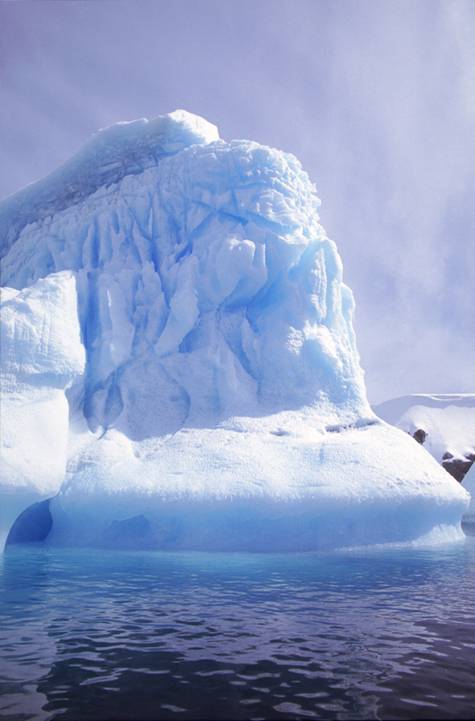

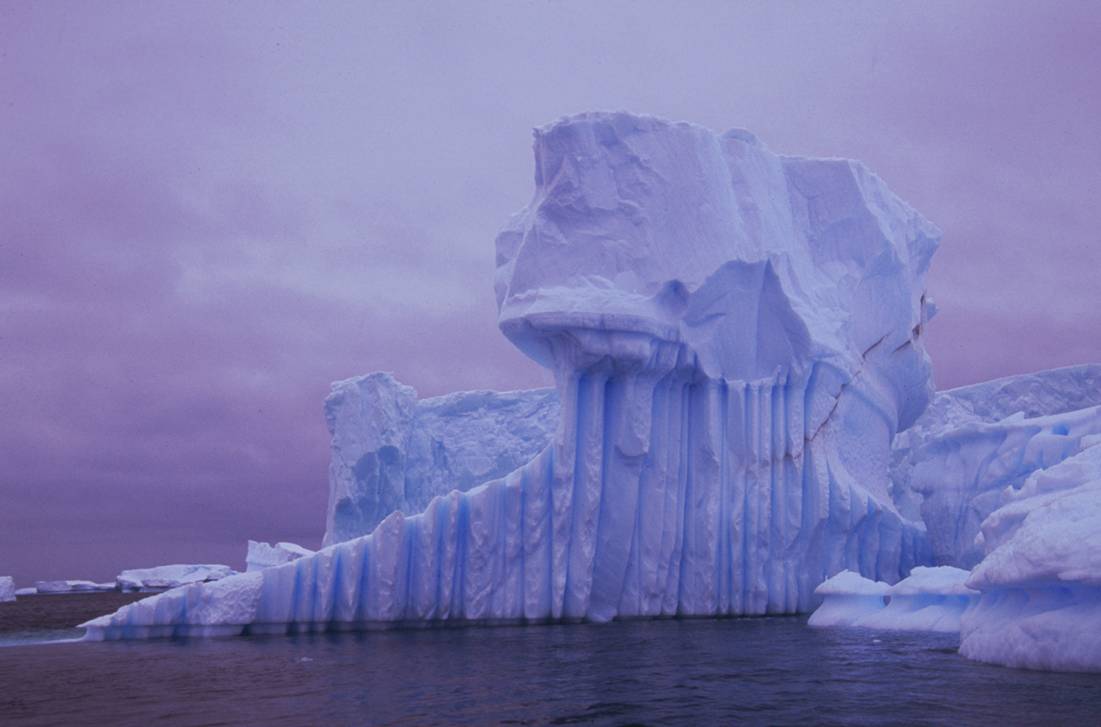
Day
6, Dec. 6, 2009
In the morning, I skipped breakfast; then we all got in the Zodiacs and
sailed for Jougla Point, on Wienke Island… my least favorite stop of the trip!
It was just another penguin island, full of mud, snow, and penguin fish
poop, its only claim to fame being a bunch of whale bones sticking up out of the
snow with the usual messy gentoos all around.
After an hour we were rescued and we went just across a small channel to
Port Lockroy, a former British scientific station that is now a museum and gift
shop, the only one on the whole continent. It
is also the only place in the world where you can buy official Antarctica stamps
and mail things, though it can take 6 weeks for them to be delivered, since
anything you mail home from there has to go by boat to Argentina, then by plane
to England, then by regular mail to the US, therefore hitting four continents;
quite a trip for a little postcard. I
got me a nice red Antarctica shirt, though I couldn’t try it on, thinking,
"I hope it fits, because I sure can't take it back if it doesn't!" (but it did). Only 5 people live
there at the station, but almost all the ships stop there, so they get lots of
visitors, and all their profits go to scientific research.
In the afternoon we were supposed to finally step foot on the actual
continent of Antarctica for the first time, not just on the various islands.
There are practically no seashores on the Antarctic peninsula, the
mountains and cliffs go straight up from the sea with hundreds of feet of ice
and snow on top of them, and the few breaks between mountains are filled with
glaciers. But Paradise Harbor is a
good, large, sheltered cove, with several places to land.
The
whalers of a hundred years ago recognized the uniqueness of this place, and even
its extreme beauty with its majestic icebergs and the reflections of its
mountains in the water, for they gave it its name.
But that afternoon, two other ships were there
already. You can sail for days in
Antarctic waters and never see another ship, but the few that are down there all
head for Paradise Harbor. The spot
where we were supposed to go ashore, at a closed Argentinean base called
Almirante Brown, already had a ship right in our spot – a ship twice as large
as ours. That was also the very
place we were planning to do our overnight camp-out.
I had signed up for that 6 months earlier – hardly any trips offer a
camping option, where you can actually spend the night on the continent in
tents, so I jumped at that opportunity immediately.
Not many other people did, there were only 25 of us or so who chose
to. That other ship wouldn’t be
sailing on until 8 pm, they told us. So
all we could do was wait around until they left.
They decided to move our supper back an hour earlier; it was the night we
were to have the always popular main-deck outdoors barbecue.
Then we’d all go ashore onto the continent after 8.
Paradise
Harbor:


The kitchen crew had a very elaborate setup on the front deck – lots of
meat, everything served buffet-style, with everybody at picnic tables; it was
lots of fun, and different from the usual formal sit-down, chatting-to-strangers
meals in the dining
room which I disliked more and more each day.
But this kind of thing was an example of what I really did like about
this company and ship – they really tried hard to be always doing something
different, something extra just for the fun of it, even when they really
didn’t have to – like the pirate boat!
Finally that evening, we got in the Zodiacs and headed for land!
We headed for the Almirante Brown station, which was just a few little
metal buildings near the sea sometimes used by Argentinean scientists.
They had built some steps down the slippery rocks to the water’s edge,
which was sensible, but I was disappointed that my very first step onto the
continent of Antarctica was onto concrete! But
when I got to some rocks, I jumped on with both feet.
I was there!!
Most of the people then headed for the highest point, a hill behind the
station, which was quite a hard trudge with the typical impossible-to-walk-in
snow. But from the top, clear back
down to the sea, several hundred yards, you could slide the whole way down on
your bottom, and fast, too. There
was a rather deep, long chute formed in the snow, quite slick and icy from all
the people from the last ship who had done the slide… if any poor penguin
stumbled into it, and I’m sure some did later, it would have been a totally
helpless goner with absolutely no way to stop the steep, wild descent; it would
have just gone faster and faster for the ride of its life.
It was hard enough for the people to control their speed on that bouncy
slope. Sometimes it even shot you up
into the air, before you landed with again with a hard crunch, then sped on
down.
Those of us who were going to spend the night had to start choosing our
spots and setting up the tents. The
ship supplied us with a tent, two thin mattresses, and a sleeping bag.
I knew that would make for one miserable night, so I had cheated by
bringing an air mattress, and a pillowcase to stuff my coat in, to make a
pillow. I was probably the most
comfortable camper there.
But after setting up camp, I had a very solemn duty to perform.
I have several people that I write emails to occasionally, some that I
have never even met, or just met once or twice in real life.
Of course I had told them all about my upcoming trip to the bottom of the
world. One of them, in Hawaii, was
quite interested in my trip, and he told an older lady friend of his in Arizona
where I was going. She had lost her
husband not too long ago, and so she came up with a very unusual request for me,
especially odd since I was a total stranger:
would I be willing to take some of the ashes of her cremated husband and
scatter them in Antarctica? He had
been quite a traveler, and that was a place he would love to have gone, but
never got to. At first of course I
was thinking, oh, yuck, no! But the
more I thought about it, I thought, why not?
It would make the grieving widow very happy, it would give my trip a
little purpose, and so the trip wouldn’t just be all about me.
So I wrote and said of course I would, and what’s more, I would be
happy to scatter some at the most beautiful sites in Argentina and Chile, too,
if she wanted me to. She certainly
did! She was delighted.
I didn’t know if there were any kinds of rules or laws about carrying
ashes to foreign countries on planes, but it was too late to bother finding out,
so she said she would just go ahead and send some to me; not a lot, just a
symbolic amount, a few ounces.
A few days later, right after I got up one morning at home, I stuck my
head out the front door and got the mail from the box on the porch like any
other day, not really thinking. One
envelope contained a check – that was nice; another one also was a check; wow,
that was really nice. And this third
thing, a rather large, thick envelope… what was this?
I just ripped it open, still kind of sleepy; I pulled out some zip-lock
bags with some weird gritty stuff in them, stared at them stupidly thinking,
what on earth? Then I went “Yaaaaack!!!”
and dropped everything on the floor of the living room!
Richard had arrived.
I figured it would be more efficient to put his remains into a small
plastic bottle with a tight lid, easier to hide in the suitcase.
I sure didn’t want those zip-lock bags to possibly break in flight –
it would get all over my clothes, I’d be grossed out for life, would waste
valuable vacation time looking for a laundromat in Patagonia, and have to wash
everything I owned, throw away the suitcase, and the poor dead guy would have
the indignity and ignominy of being washed down a South American sewer system.
Not what the poor widow had in mind.
So he rode to Argentina and then to Antarctica with me in a little
bottle, uneventfully; though if it had been discovered by some authorities, I
never did manage to come up with a good idea for what I would tell them.
But I never had to.
That night in Paradise Harbor, after everybody else had long left the hill with the
slide on it, and most were settling into their tents, I started the trudge up to
the peak. I hadn’t gone up before
when everybody else did, I didn’t see any sense in doing it twice.
The bottle was in my pocket, and I had the whole place to myself, the
only person on the mountain. It was
the hardest hike I had taken so far on the trip, and many times I looked back
down, thinking wow, I’m still not even halfway up, and of course the snow was
the usual sink-to-your-knees-with-every-step variety.
Eventually the slope flattened out a bit, and it got a bit easier, then a
lot easier. I actually got to the
very top of the rocky slope sooner than I expected.
Still, it wasn’t just a pleasant stroll, it was hard work.
It could hardly have been more perfect.
I hadn’t wanted to just sprinkle it out on the unstable snow, I wanted
actual rock, the genuine land of Antarctica.
99.5% of the continent is covered permanently in ice and snow, so I knew
it might not be easy to find an appropriate spot, but the top of that hill was
windswept nice and clear. I wanted
the wind to do the scattering. Some
sun would have been nice, but after all, it was almost 11 pm, so that was asking
a bit much. It was still very light
though, and I could see for probably 50 miles from my lofty viewpoint.
Some mountains far into the interior still did have bright sun on their
peaks, glowing pink and orange in the hazy distance.
I sat there on some dry rocks, amazed at how warm it seemed, though it
was just about freezing temperature actually.
There was no wind at all, practically unheard of in Antarctica, the
windiest place on earth, though it was probably the hard climb that made me feel
warm. So I sat there, enjoyed the
grand views all around my little perch, meditated on many wonderful things, and
said a little prayer. Precisely at
11 pm, I uncapped the little bottle, and sprinkled some of Richard out onto the
highest rock of all, saving the rest to scatter later in South America.
I just made a little pile so the wind could do the scattering, except
there wasn’t any at the moment. But
I knew it would sooner or later come in off the ocean and blow the remains to
the interior of the continent, where it would rest, quite possibly for thousands
of years, before the falling snows would turn to ice, then became a glacier,
flowing to the sea with infinite slowness, finally breaking off into an iceberg
that could drift for thousands of miles before dissolving at last into the
ocean, where all life began in the first place.
After a few more minutes, it was time to go to bed.
I deserved a bit of fun first though… the long slide to the bottom.
I had to do it! So I did. It was steep,
scary, fast, even dangerous – sometimes I got going so fast I simply
couldn’t stop at all, till I’d hit a little dip and could dig my feet into
the snow. I was thrown around every
which way on that crazy Antarctic snow chute.
It was one of the wildest rides I’ve ever been on in my life, better
than any roller coaster, and scarier, too.
Nobody back at the camp seemed to notice I’d been gone for quite a
while. Some had already turned in,
though one group had brought along a bottle of wine, and another group was
trying to play poker with a set of Uno cards, which started blowing all over the
place soon after, as the wind came up. But
I was tired, so I crawled in and zipped up the tent.
As I was about to make my coat into a pillow, I emptied out my pockets.
I had my sunglasses, my film, my gloves, and the cookie I had snitched
from the barbecue on deck… but where was the little plastic bottle?
I searched and searched, checking every possible pocket a dozen times,
then searching all over the little tent, under the mattresses, inside my boots,
in the sleeping bag, everywhere! Nowhere
to be found. I had lost Richard!
Then it dawned on me – it must have slipped out on my wild ride down
the mountain side! But surely I had
zipped up my pocket? I nearly always
did. This was quite upsetting, and I
really didn’t sleep very well that night, worrying.
I knew the next morning that I would just have to make the dreary climb
all over again, clear to the top, and then try to retrace my long slide down, as
slowly as possible, though that would be really difficult to do on that steep,
slick slope. Besides that, it was
highly unlikely that it would be just lying there somewhere in full sight – it
would no doubt be buried deep into some of the many snowbanks I had crashed into
and bounced off of.
So I had an unhappy night. I
was not at all looking forward to the practically impossible duty of looking for
the bottle across a mountainside of deep snow.
If I didn’t find it, I would just have to tell the widow that I had
decided to just stick with the original plan… to leave it all in Antarctica
and not take some of him to other places in Argentina and Chile.
She would no doubt be fine with that and grateful for what I had already
done (I wouldn’t mention the loss of the bottle); but I was not
happy about it at all, I had failed in my duty.
I couldn’t get comfortable all that night.
It was warm enough, but my legs hurt from the climb to the peak, or
perhaps I got them bashed up on the way down without realizing it at the time.
But they ached all night long. Some
people outside were still talking and laughing for hours.
I could hear snoring from two different directions. It never did get a
bit dark all night, so I pulled my toboggan cap clear down over my eyes, which
was very effective at producing total darkness.
But have you ever been lurched wide awake a dozen times during the night
by a screeching penguin about 2 feet from your head?
I must have plopped my tent right along their preferred path to the sea
or something, or maybe they were just inspecting this strange green igloo I was
in, or checking how well I had planted my tent stakes, and making loud negative
comments to their companions, who would then holler back from the other side of
the tent.
The
hill:

Day
7, Dec. 7, 2009
Maybe I slept more than I thought I did, because before long I
heard the sounds of the people next door tearing down their tent and packing
their stuff, all the while talking and laughing, which I thought was excessively
rude, when all I wanted was more sleep. I
checked, and it was only 4:30 a.m.! I
hadn’t realized though, that the Zodiacs were coming back from the main ship
at 5:30 a.m., which had sailed clear out of sight miles away after dropping us
off the evening before, to the mock consternation of everybody.
So we were supposed to be all packed and ready to leave by then.
It still didn’t seem all that cold, I had slept in my longjohns and ski
pants, so crawling out of the sleeping bag and starting to pack up wasn’t too
hard, except for me being still totally tired.
But I knew I had to climb that big hill again, and quickly, too.
After I got all my equipment ready to go inside the tent, I unzipped the
tent flap, peered outside, and let out a big, loud whoop.
Right there, outside my tent door in the snow, was a little bottle, right
where it had somehow fallen the night before.
I had found Richard!!
After a bouncy, wet ride in the boats back to the ship, I headed straight
for my room, crawled into bed, skipped the next two meals, and slept for 6 more
hours. What a night on the continent
that had been…!
I didn’t get up till the afternoon.
Everybody else went ashore to Cuverville Island, but I was way too tired
from the lack of sleep the night before; I figured it was just another dirty
penguin colony island anyhow, and from what I heard when they came back, it was.
But later in the day, we reached Foyn Harbor, so this time I went out for
the afternoon expedition. We
didn’t land anywhere, we just got in the Zodiac boats and ran around along the
coastline of Enterprise Island and around some icebergs.
It was one of the most beautiful areas of all.
The 6 little boats all scattered in different directions, so it was like
we were practically alone.
Behind the little island, we came upon an amazing sight.
An old, rusty shipwreck. It
was the Norwegian ship Guvernøren, the first ship ever built that was a
complete factory ship for processing seals.
It used to be that they would catch the seals, then process them for
their meat, fur, and oil at on-shore sites, which were expensive to build and
maintain; so to do it all on board a ship was much more efficient
(unfortunately, since they all but drove the seals to extinction).
But the ship ran aground almost 100 years ago, and now was just a
leaning, half-sunken, rusty hulk. It
had caught on fire because of all the seal oil on board, and so they just drove
it toward land, jumped overboard, and abandoned ship.
Nobody died, it was right near land where they wrecked it, and all
escaped. It was tilting so much we
could look onto the main deck and see all the strange, rusty, heavy equipment,
right there still on board.
Guvernøren:
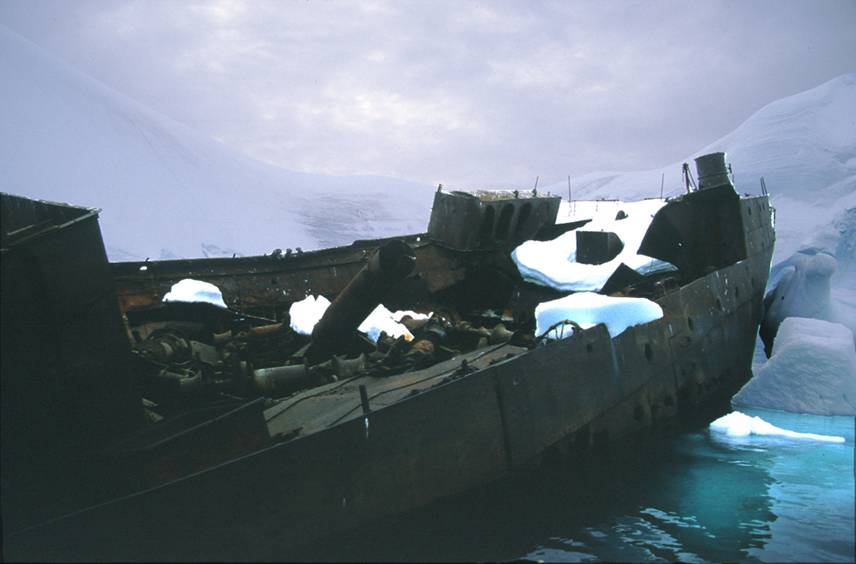
Then we headed to a quiet icy cove, where there were seals resting on the
snow, rolling around and acting silly -- now a protected species.
And up on a cliff to the right was the grandest ice arch I ever saw!
It looked like it might collapse at any second, and it could… but they
said it had been standing for 4 years or more so far.
I had seen several icebergs that had melted into arch shapes, but this
was the only one I saw on land.
Vladimir was the driver of our Zodiac boat this time.
I hadn’t been on his boat before. He
seemed to me to be the perfect example of the silent, stoic Russian, going about
his work without a word, wrapped up so warmly that all you could see was his
nose. It seemed he didn’t speak
English. Anything we said to him
just got answered with a nod or a “no”.
But he was a good, careful driver, unlike some of them who enjoyed
scaring us in those inflatable rafts, though that was fun too.
But when I asked him if he could take us around a corner of the island to
a position where I’d be able to see the sky underneath the ice arch, he seemed
to know what I meant, and took us to a great viewpoint, where he made sure I got
all the pictures I wanted. Then we
headed back to the ship, with him standing back at the motor like a Russian
stone, wordless, expressionless.
The
Ice Arch:
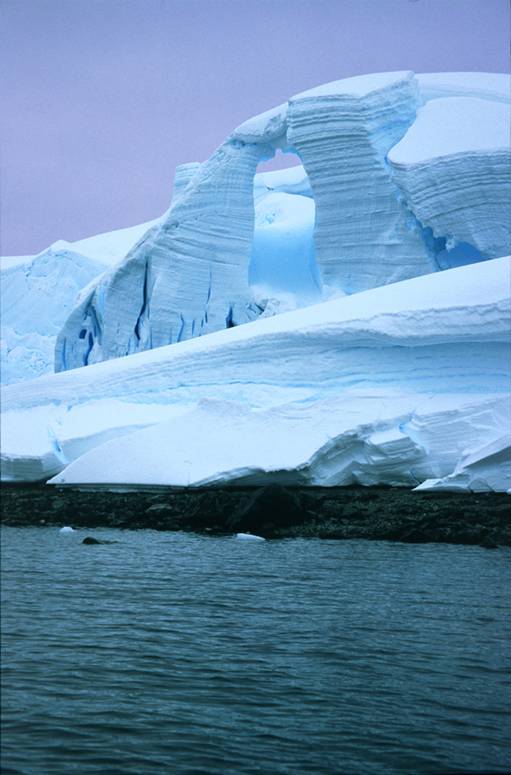
Day
8, Dec. 8, 2009
Deception Island! It’s a
weird place. There aren’t many
places where you can sail a cruise ship into the crater of a volcano, but
that’s what we did. Imagine an
enormous volcano under the ocean, with only the very top sticking above the
water, the crater. A narrow passage
has broken through from the ocean to the crater, and filled it with water; so
the island actually looks, from the air, kind of like a donut with a bite taken
out of one side. If a large ship is
very careful, it can sail right on in, but it has to really hug the cliff walls
on the right, because, even though it looks like the passage is plenty wide,
they know that there are dangerous rocks just 8 feet under the water that would
scrape the hull wide open. So we
entered very slowly.
Deception
Island… I didn’t take this picture of course, it’s a view from the air:
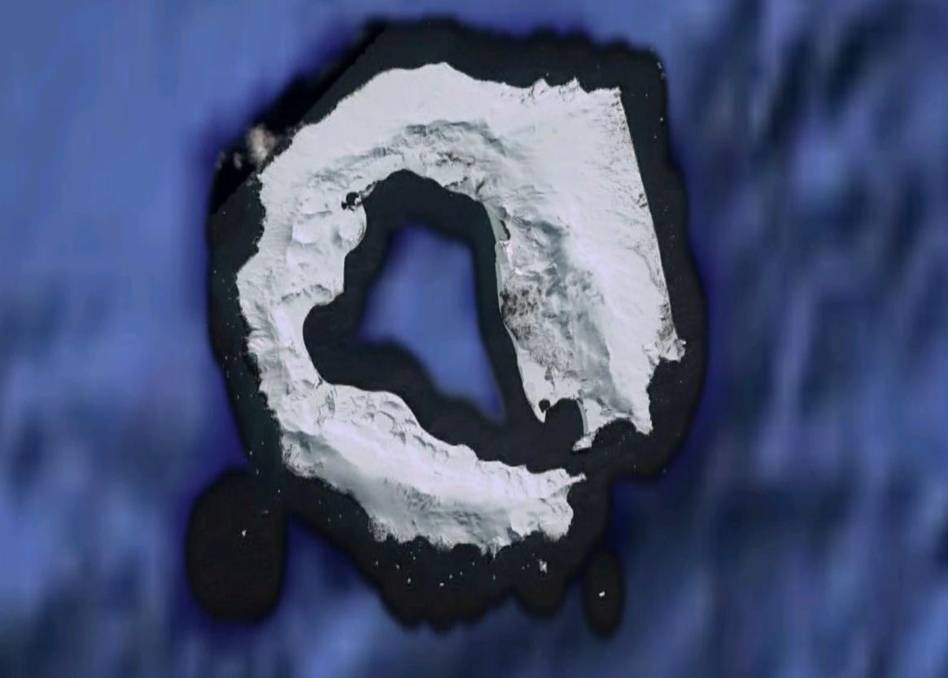
Sailing
into Deception Island:
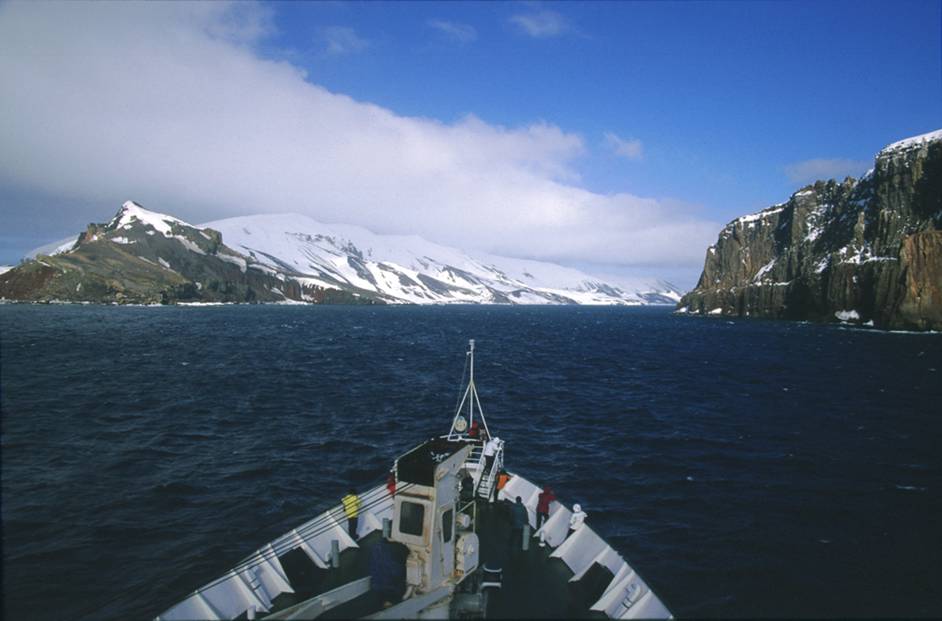
Inside
Deception Island -- three gentoos, black sand beach, and the iceberg.

The ship anchored in the middle of the crater, and all around us were
low, snow-covered hills – not the usual sharp, rocky terrain we had seen up
until then on the Antarctic peninsula. This
was a totally different geology. We
all got in the Zodiacs and headed for a black sand beach on the western, inside
shore. This was to be the site of
the famous polar plunge! More than
half of the passengers were determined to do it, to go swimming in the Antarctic
ocean. I most emphatically was not
one of them; as I told those who asked, “I’ve already done my crazy thing
for the trip, camping out on the snow overnight.”
So I felt no need at all to prove I was tough or whatever by going
swimming in nearly frozen water. I
even hate typical backyard swimming pools, they are always too cold for me even
in the middle of summer. So I just
went along to see the penguins and the frozen people.
In the whole bay inside the crater, which is really quite large, there
was only one iceberg – not many manage to come floating in through the narrow
passage from the sea. It had somehow
parked itself, quite ironically, directly in front of the beach where the polar
plunge was to take place, even though there were about a thousand other places
where it could have gone just as easily. Served
’em right, I thought. The reason
they always pick that particular spot to go swimming is because the volcano is still active. It last erupted in
1969, and sometimes the water in certain parts of the bay gets up to 150°.
Most of the time though, it is as cold as anywhere else in the Antarctic,
as it was that day… or worse, because of the iceberg.
So most of the people just did a wild dash in their swimming suits out
into the water up to maybe neck level, then back out even faster, where large
white towels were held ready for them to wrap up in.
One guy from Israel tried to swim out to touch the iceberg, but he said
later that partway there, he simply froze up and could barely move his arms.
Luckily he could still touch bottom, so he turned and walked back in as
quick as he could. After they dried
off though, several reported that they didn’t really feel all that cold, since
they didn’t really manage to stay in long enough to get chilled all the way
through. After watching the silly
people, I went off and watched the silly chinstrap penguins, which we hadn’t
seen any of since the first day, and just 2 or 3 then.
Deception Island has thousands of them, and there were some seals on the
beach too.
Later, back on the ship, we sailed back through the narrow strait, just a
few feet from the giant cliff walls again, and back out into the open sea.
We had one more stop to make, our final landing.
The South Shetlands Islands are just to the north of the Antarctic
Peninsula. We sailed past the large
Livingston Island, and stopped at little Half Moon Island, where Argentina has a
small base called Cámara Base. Once
again, there were lots of penguins, mostly chinstraps.
This island, being slightly warmer than Antarctica itself, had lots of
rock showing through the snow, often with bright orange and yellow patches of
lichens growing on them, making it the most colorful place we saw.
I made the long tramp from the landing spot up to the base through the
deep snow, then slid back down the hill for the fun of it.
On
Half Moon Island, with Livingston Island in the background.

Back on board again, we passed more of the South Shetland Islands that
evening, turned north, and took off across the Drake Passage once again, headed
for South America. The great icy
continent was behind us. Larger than
Australia, larger than Europe… the most unknown, unexplored, unspoiled place
on earth. And one of the most
magnificent. We felt sad – how
many of us would ever see that grand land again?
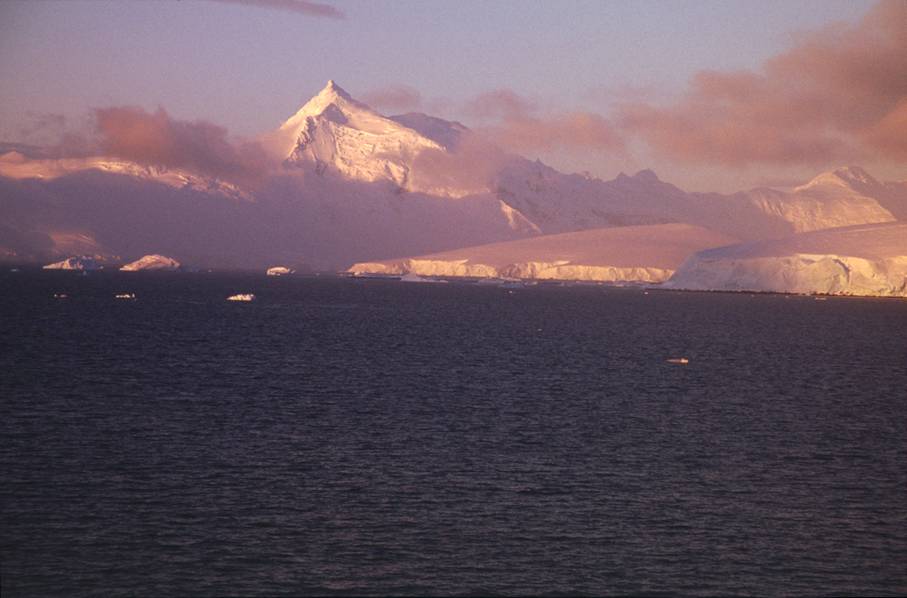
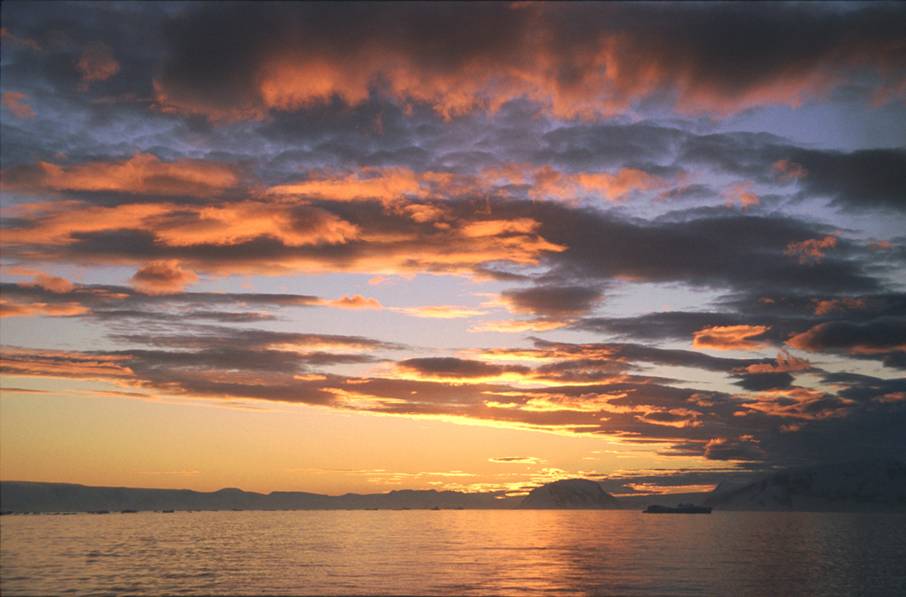
So the crew, knowing our mood, had a special treat in store that night.
Everybody was told to gather in the forward lounge, a room big enough to
hold everybody, as long as several people sat on the floor.
Music started, and what should happen next?
A Russian variety show! All
of our Russian crew had a part, the waitresses, the boat drivers, the engine
room workers, everybody except the captain, who was still up on top driving the
ship. They had on beautiful
costumes, and danced and sang; comic songs and serious ballads, love songs and
country dances, and even dragged part of the audience up to take part in an
elaborate folk dance that took up half the room.
It was amazing to see our dining room waitresses, Natasha, Elena, Katya,
and the others, all dressed up in their native costumes – what a change.
But the big surprise was the M.C. of the whole evening… the announcer.
It was Vladimir, the silent boat driver, who turned out to speak
perfectly fine English after all. He
was up there with a crazy sailor hat on, with its ribbons sticking straight up
in the air. He did all the
introductions and jokes and explanations for the show, then at the end the
others got him to perform his famous jump, where he jumped high, did the splits
in mid-air, and touched his toes at a level with his ears.
It was such a hit we wouldn’t let the show end until he did it again!
Day
9 and 10, Dec. 9 & 10, 2009
The Drake Passage! It was horrible!
This time we got to see it as it usually is, or maybe even worse than
average. I simply stayed in bed
trying to read a book for the whole two days, sleeping as much as possible.
I did lurch down to the dining room a time or two, wondering why the
tablecloths were all wet. “So the
plates won’t slide onto the floor,” I was told.
Oh. Quite a few people went
sliding, though.
But I didn’t get sick at all. I
was quite the seasoned sailor by now, apparently.
I still can’t figure out why they built the narrow beds in the cabins
alongside the two side walls, instead of along the other two… that meant that
your head bobbed a couple of feet up and down every time the boat rocked, which
was every few seconds; and so did your feet.
If the beds were placed parallel with the ship, you would just rock a bit
side to side, but no, we had to endure two whole days and nights being in beds
that behaved like see-saws.
Day
11, Dec. 11, 2009
We woke up to calm waters, and land on both sides!
We were in the Beagle Strait once again, with Tierra del Fuego on one
side and Navarino Island on the other, with quite warm weather now.
We hadn’t see trees or a blade of grass for 10 days, but Tierra del
Fuego is amazingly green. Soon
Ushuaia appeared – wow, civilization; cars, houses, ships, and the big sign
again: End of the World, Beginning
of Everything! But no. WE
had been to the end of the world. And
made it back again.
(
)
(
)
(
)
(
)
(
)
(
)
(
)
\ /
\/
It
was a windy day…
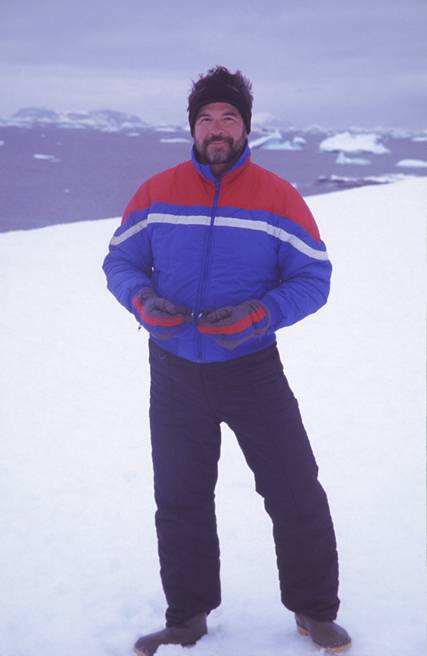
click
here to see Page 2.